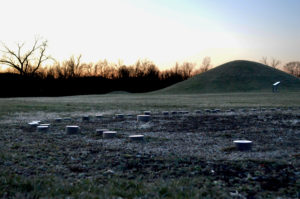 The Ancient Ohio Trail (AOT) is a comprehensive collection of travel routes and resources designed to help tourists discover “the distinguished Native American Culture in the Midwest,” according to the AOT website. AOT also offers virtual excursions to experience earthworks as they were believed to have been before they were damaged or destroyed.
The Ancient Ohio Trail (AOT) is a comprehensive collection of travel routes and resources designed to help tourists discover “the distinguished Native American Culture in the Midwest,” according to the AOT website. AOT also offers virtual excursions to experience earthworks as they were believed to have been before they were damaged or destroyed.John E. Hancock, a professor emeritus of architecture at the University of Cincinnati, is the man behind AOT. Hancock started the project in 2007, and through funding from the National Endowment for the Humanities and partnerships with the University of Cincinnati and Ohio State University Newark, AOT has grown to include 12 scenic routes as of 2011.
The idea behind AOT came to Hancock during a project at the University of Cincinnati, during which he created digital renderings of various ancient earthen mounds, effigies and enclosures around the state. He and his colleagues traveled around Ohio for roughly 10 years studying the various sites.
“It was at that point that I was particularly inspired to create something which would highlight the cultural heritage tourism potential of this whole region,” Hancock says.
Southeast Ohio is prominently featured along the Ancient Ohio Trail, with routes near Lancaster, Marietta, Chillicothe and Athens.
The Village of Zaleski is home to Zaleski State Forest. The forest is located approximately 30 minutes outside of Athens, primarily in Vinton County. On the grounds of the State Forest Headquarters is the Zaleski Mound. The grassy mound stands elegantly, ringed with a gravel path and surrounded by saplings.
“I love the Zaleski Mound,” Hancock says. “I think it’s probably the most beautiful mound in
Ohio.”
Hopewell Culture National Historical Park, located in Chillicothe, features the beautiful Mound City. Mound City is a 13-acre earth enclosure filled with roughly 23 dome-shaped mounds, although one is an elliptical. The walls of the enclosure sit between three and four feet tall, with entrances at the east and west ends.
Making Strides Toward UNESCO World Heritage Inscription
The unique and historic earthworks have caught the attention of the United Nations Educational, Scientific and Cultural Organization (UNESCO). Through the work of World Heritage Ohio, four of the main earthwork sites featured on the Ancient Ohio Trail – Fort Ancient, Mound City, Serpent Mound and Newark – have been placed on the U.S. Tentative List for inscription on the UNESCO World Heritage List. If these sites are placed on the list, they will enjoy the benefits of increased tourism, awareness, control and sovereignty.
The Ancient Ohio Trail provides tourists with a high-quality travel experience perfect for a day trip or weekend excursion.This summer, rather than spending a fortune on cultural tourism abroad, travelers can hop in the car, channel their inner historian and get in touch with Ohio’s
roots on the Ancient Ohio Trail.
